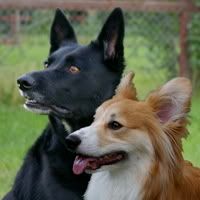If you push down on most dogs, they have a natural instinct to resist the pressure. Pushing on them makes them feel vulnerable and threatened, so they push back. It doesn't mean your dog is trying to be "dominant" or rebel against you, and he shouldn't be corrected or punished for this. I am of the opinion that if you can train a dog to do something without being physical, then more power to you! Dogs learn to think more when they are given the opportunity to figure out how to do things on their own, rather than being pushed into doing it.
Instead of push your dog down, a better method is to lure him into the position with a treat, and reward him as soon as his little belly hits the floor. Once he's doing it consistently, then you would start saying "down" as he performs the action. This connects the command "down" to the now reliable action of him lying down. So far, I have not been given a reason to push a dog into the position I want him to be in. Sometimes you may have to just out-wait them till they realize which action gets them the treat, but they're all going to get it eventually!
Once the dog learns how to sit or down reliably in the home, often owners try to rush things, and they take him to the pet store, the dog park, or a friend's house, where he suddenly won't listen, and would rather sniff and play than even look at the owner. This can be frustrating I know, but your dog is not ignoring you or being dominant, and it's unfair to him to punish him for giving in to distraction when he doesn't know any better.
When a dog is suddenly put in a new environment with all kinds of interesting new smells and things to discover, he is overwhelmed and most likely will not sit when you tell him to, because although you taught him "sit" inside the house, you haven't yet taught him to sit with all these new people and bikes and other dogs around. This is simply the next step in training. After a dog has learned a behavior in his home, he needs to be slowly moved up to performing the behavior around lots of distractions.
If you always keep in mind that your dog is not always trying to "one-up" you, training becomes a lot easier. I never did have any luck pushing dogs down like my parents told me to. My outlook on training has changed a LOT since I was a kid, and I remember that my relationship with my dogs wasn't that great back then. Once I embraced the view that my dog is not constantly trying to overthrow me by instinctually resisting me here and there, the training just fell into place, and I had happier, better behaved dogs is a result.
All articles on this blog are written by Victoria Steen unless otherwise stated. They are NOT to be redistributed.
